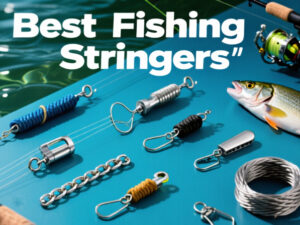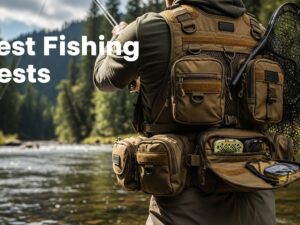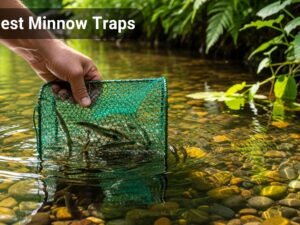Spring fishing season brings renewed excitement as waters warm and fish become more active after winter. Whether you're targeting bass during their spawning season or pursuing crappie in shallow waters, having the right gear makes all the difference. The 10 essential fishing items for spring include a quality rod and reel combo, fresh fishing line, tackle box, variety of lures, hooks, weights, bobbers, fishing pliers, valid fishing license, and sun protection gear.
As ice melts and temperatures rise, fish move from deep winter haunts to shallow spawning areas. This seasonal migration creates prime fishing opportunities, but success depends on proper preparation and equipment selection.
This comprehensive guide reveals the must-have fishing items for spring, including essential fishing equipment for beginners looking to start their angling journey. You'll discover exactly what gear to prioritize, how to choose quality equipment within your budget, and expert tips for maximizing your spring fishing success.
1. Quality Rod and Reel Combo
Your fishing rod and reel form the foundation of your spring fishing arsenal. For versatility during spring's changing conditions, a medium-action spinning combo works excellently for most situations.
Choose a 6.5 to 7-foot rod that balances sensitivity with casting distance. This length handles everything from dock fishing to covering water from shore. The medium action provides enough backbone for solid hooksets while maintaining flexibility for fighting fish.
When selecting the best fishing gear for beginners, prioritize user-friendly spinning reels over complex baitcasting models. Quality entry-level combos from reputable brands cost between $50-100 and provide years of reliable service.
Rod and Reel Selection Tips:
- Test the rod's action by gently flexing the tip
- Ensure smooth reel operation with no grinding sounds
- Check that rod guides align properly
- Verify comfortable grip fit for extended fishing sessions
2. Fresh Fishing Line
Spring demands fresh line after winter storage can weaken or damage your existing line. Old line leads to lost fish and frustration, making replacement a critical spring preparation step.
Monofilament line remains the top choice for beginners due to its forgiving nature and affordable price. Choose 10-12 pound test for versatile spring applications, handling both finesse presentations and larger fish.
For anglers pursuing bass around heavy cover, consider upgrading to 15-20 pound fluorocarbon. This nearly invisible line excels in clear spring waters while providing superior abrasion resistance.
Spring Line Recommendations:
- Light Tackle: 8-10 lb monofilament for panfish and trout
- All-Purpose: 12-15 lb fluorocarbon for bass and walleye
- Heavy Cover: 20-30 lb braided line for thick vegetation
3. Well-Organized Tackle Box
A quality tackle box transforms chaotic gear storage into efficient organization. Spring fishing often requires quick lure changes as conditions shift throughout the day.
Look for boxes with adjustable dividers accommodating various lure sizes. Waterproof seals protect contents from spring rain showers and accidental splashes. Clear lids allow quick visual inventory without opening compartments.
The best tackle boxes for fishing feature multiple trays for categorizing gear by type. Dedicate sections for hooks, weights, lures, and terminal tackle to minimize search time on the water.
4. Diverse Lure Selection
Spring fishing success often depends on matching lures to rapidly changing conditions. Fish behavior shifts daily as water temperatures fluctuate and spawning activities progress.
Essential Spring Lures Include:
| Lure Type | Best For | Key Colors |
|---|---|---|
| Soft Plastic Worms | Bass in cover | Green pumpkin, black |
| Crankbaits | Covering water quickly | Shad, crawfish patterns |
| Spinnerbaits | Windy conditions | White, chartreuse |
| Jigs | Bottom fishing | Black/blue, brown |
| Topwater plugs | Early morning/evening | Natural baitfish colors |
Texas-rigged plastic lizards trigger aggressive strikes from protective bass during spawn. These versatile baits work through cover without snagging, making them perfect for spring's weedy shallows.
Hard-bodied jerkbaits excel when fish suspend in transitional areas. Their erratic action mimics wounded baitfish, triggering strikes from otherwise reluctant fish.
5. Sharp, Quality Hooks
Nothing ruins spring fishing faster than dull or bent hooks. Fish often strike aggressively during spring, but poor hooks result in missed opportunities.
Stock multiple hook styles and sizes for various presentations. Extra-wide gap hooks handle bulky soft plastics, while lighter wire hooks preserve live bait action. Aberdeen hooks bend slightly to release from snags, preserving your tackle in spring's shallow cover.
Spring Hook Selection:
- Size 2/0 to 4/0 EWG hooks for bass plastics
- Size 6-10 for panfish and live bait
- Circle hooks for catch-and-release fishing
- Weedless hooks for heavy vegetation
6. Appropriate Weights and Sinkers
Spring's shallow water fishing requires finesse weight selection. Heavy weights spook fish in clear, shallow conditions common during early spring.
Bullet weights from 1/8 to 3/8 ounce cover most Texas-rig applications. Split-shot sinkers allow precise depth control for finesse presentations. Tungsten weights provide sensitivity advantages, transmitting bottom composition through your line.
For fishing lakes with varying depths, carry an assortment allowing quick adjustments. Wind conditions often dictate weight selection as much as water depth.
7. Quality Bobbers and Floats
Bobbers aren't just for beginners, they're essential spring fishing tools. Slip bobbers allow precise depth control when crappie suspend at specific levels. Fixed bobbers excel for presenting live bait in shallow spawning areas.
Modern bobbers feature high-visibility colors and sensitive designs detecting light bites. Spring's often subtle strikes require bobbers that signal the slightest line movement.
Choose smaller bobbers for calm conditions and larger models for choppy water. Weighted bobbers cast farther, reaching fish beyond normal casting range.
8. Multi-Function Fishing Pliers
Quality pliers rank among the most-used spring fishing tools. From removing hooks to cutting line, pliers handle countless tasks throughout your fishing day.
Stainless steel or titanium construction resists corrosion from wet spring conditions. Spring-loaded handles reduce hand fatigue during extended use. Built-in line cutters eliminate fumbling for separate tools.
Many modern pliers include additional features like crimping sleeves and split-ring tools. These multi-function designs reduce tackle box clutter while increasing efficiency.
9. Valid Fishing License
Before hitting the water, ensure your fishing license remains current. Spring often marks new license years in many states, catching unprepared anglers with expired credentials.
Purchase licenses online for convenience, printing immediately or saving digital copies on smartphones. Many states offer multi-year options providing savings and convenience. Don't forget required stamps or endorsements for specific species.
Research local regulations for spring fishing seasons, as many waters feature special rules protecting spawning fish. Size and bag limits often change seasonally.
10. Sun Protection and Safety Gear
Spring's increasing sun intensity catches many anglers unprepared. Quality polarized sunglasses reduce glare while revealing underwater structure and fish. UV-protective clothing prevents painful sunburns during long days on the water.
Include these safety essentials:
- SPF 30+ waterproof sunscreen
- Wide-brimmed hat or cap
- First-aid kit for hook injuries
- Insect repellent for emerging bugs
- Rain gear for spring showers
Spring-Specific Fishing Considerations
Understanding spring patterns improves success regardless of equipment quality. Water temperature drives fish behavior more than any other factor during spring months.
Water Temperature Guidelines:
- 45-55°F: Fish remain sluggish, use slow presentations
- 55-65°F: Pre-spawn activity increases, fish feed aggressively
- 65-75°F: Peak spawning occurs for many species
- Above 75°F: Post-spawn patterns begin
Target shallow, protected areas that warm first. Coves, backwaters, and dark-bottomed areas absorb sunlight quickly. Northern pike become especially active in these warming zones.
Common Spring Fishing Mistakes to Avoid
Even experienced anglers fall victim to spring fishing mistakes. Avoid these common errors to increase your success rate:
Fishing Too Deep: Spring fish move shallow, often in just feet of water. Resist the urge to fish winter's deep patterns when temperatures climb above 50°F.
Using Heavy Tackle: Clear spring water demands downsizing line and lures. Fish see everything in shallow water, making stealth critical.
Ignoring Weather Fronts: Spring's volatile weather creates rapid condition changes. Cold fronts push fish deeper temporarily, while warming trends draw them shallow.
Overlooking Spawning Areas: Learn to identify spawning habitat for target species. Understanding fish behavior patterns during spawn improves catch rates dramatically.
Tips for Fishing Gear Maintenance
Proper maintenance extends gear life and prevents failures during prime spring fishing. Winter storage often leaves equipment needing attention before spring use.
Clean reels thoroughly, removing old grease and applying fresh lubrication. Check rod guides for cracks or grooves that damage line. Sharpen or replace hooks showing rust or damage.
Organize tackle boxes during maintenance, discarding damaged items and restocking essentials. This preparation time investment pays dividends through trouble-free spring fishing.
Budget-Friendly Spring Fishing Setup
Quality essential fishing equipment for beginners doesn't require massive investment. Focus budget on rod/reel combo and line, as these items most directly impact fishing success.
Sample Beginner Budget:
- Rod and reel combo: $60
- Fishing line (2 spools): $15
- Basic tackle box: $20
- Assorted hooks: $10
- Mixed lure selection: $30
- Weights and bobbers: $10
- Pliers: $15
- Total: $160
Shop end-of-winter sales for significant savings. Many retailers clear inventory before spring arrivals, offering quality gear at reduced prices.
Advanced Spring Tactics
Experienced anglers can elevate spring success through specialized techniques. Electronics like fish finders reveal underwater structure and suspended fish that eyes miss.
Live bait often outperforms artificials during tough spring conditions. Understanding local baitfish patterns helps match offerings to fish preferences.
Consider water clarity when selecting line and lure colors. Stained water allows heavier line use, while ultra-clear conditions demand finesse approaches. Match lure colors to water clarity, using bright colors in dirty water and natural patterns in clear conditions.
Spring Fishing by Species
Different species require adjusted approaches during spring. Understanding species-specific patterns improves targeted success rates.
Bass: Focus on shallow spawning flats with scattered cover. Soft plastics and jigs excel during spawn, while moving baits work pre and post-spawn.
Crappie: Target shallow brush and docks as water warms. Small jigs and minnows under bobbers produce consistent action during spring crappie runs.
Walleye: Fish transition areas between deep winter holes and shallow spawning rivers. Jigs tipped with minnows or nightcrawlers produce best early spring.
Trout: Focus on slower water as spring runoff increases. Match insect hatches with appropriate flies or lures for consistent success.
Frequently Asked Questions
When should I start preparing spring fishing gear?
Begin preparing gear 2-3 weeks before ice-out or when water temperatures consistently reach 45°F. This timing allows for replacing worn items and ensures readiness for early season opportunities.
What's the most important spring fishing item for beginners?
A quality rod and reel combo ranks as most critical. This foundation piece impacts every aspect of fishing success, from casting accuracy to fighting fish effectively.
How much fishing line should I buy for spring?
Purchase at least two spools of your primary line choice. Spring fishing often requires frequent retying due to cover contact and aggressive fish, consuming more line than other seasons.
Do I need different gear for different fish species?
While basic gear works for multiple species, specialized equipment improves success rates. Lighter gear suits panfish, while bass fishing benefits from medium-heavy setups.
What size tackle box works best for spring fishing?
A medium-sized box with 3-4 trays accommodates essential spring gear without becoming cumbersome. Larger boxes stay in vehicles while smaller versions go waterside.
Are expensive lures worth the investment?
Quality lures often feature superior hooks and finishes but aren't always necessary. Mix premium lures for confidence situations with budget options for experimental fishing.
How often should I replace fishing hooks?
Replace hooks showing any rust, bending, or dullness. Spring's aggressive fish and frequent snags accelerate hook wear compared to other seasons.
Final Thoughts on Spring Fishing Success
Successful spring fishing combines proper gear selection with understanding seasonal patterns. The 10 essential items outlined provide a solid foundation for memorable spring fishing adventures.
Remember that the best fishing gear for beginners emphasizes reliability over complexity. Master basic equipment before advancing to specialized tools, building skills progressively.
As water temperatures rise and fish become increasingly active, prepared anglers enjoy spring's exceptional fishing opportunities. Stock up on these essential items early, avoiding crowds and ensuring you're ready when conditions peak.
Whether you're an experienced angler or just starting your fishing journey, spring offers unmatched opportunities for success. Take time to properly prepare your gear, study local patterns, and most importantly, get out and enjoy the wonderful world of spring fishing.
Ready to gear up for spring fishing success? Visit your local tackle shop today and start building your essential spring fishing kit. Don't let another season pass without experiencing the excitement of spring fishing at its finest!



